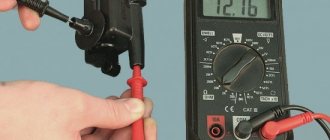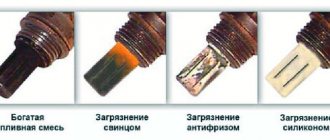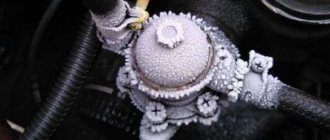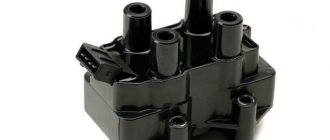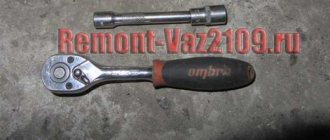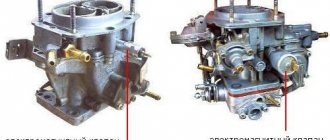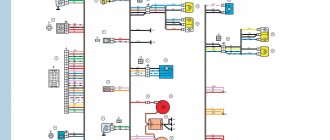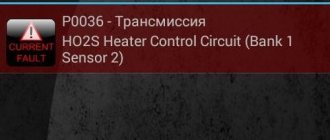The introduction of Euro-3 environmental standards required automakers to include self-diagnosis algorithms in engine controls for problems associated with gasoline misfires in the cylinders. One of the reasons for the appearance of error 0330 on the VAZ 2114, indicating a misfire, is the desire of manufacturers to increase the service life of an expensive catalytic converter. The fact is that unburned fuel and oxygen enter the catalyst, where the oxidation process continues, increasing the temperature until the honeycombs can sinter, or the gasoline accumulating in the neutralizer at one point explodes and destroys the catalyst. From the article, readers will learn what problems in the car lead to fuel not burning in the cylinders and error code 0330 appearing on the ECU display, as well as what measures should be taken to resolve the problems.
What does P0300 mean?
Trouble code P0300 indicates that one or more cylinders are misfiring. If the last digit in the code changes, for example, 0301, or 0303, then the last digit indicates in which cylinder the misfire occurs: in the first or third. Due to misfires, rotation cycles are lost and the speed becomes unstable. Incomplete combustion of the fuel-air mixture occurs. The car begins to move jerkily, engine performance drops, and fuel consumption increases.
Error P0300. ODB II error code. Diagnostics.
Random misfire detected in cylinder(s)
What does error code P0300 mean?
Most gasoline cars have 4-6 cylinder engines. During operation, a spark plug fires sequentially in each cylinder, which ignites the fuel mixture. At the moment of ignition, a micro-explosion occurs, the energy of which is transferred to the crankshaft, which transfers it further to the transmission.
If misfires occur in more than one cylinder, this increases or decreases engine speed. If such fluctuations are 2 percent or more, the engine control unit will record an error code P0300 in its memory.
If the percentage of such fluctuations is in the range from 2 to 10 percent, then the “Check Engine” will light up on the dashboard. If the Check Engine light starts blinking, this indicates that the number of misfires exceeds 10 percent and further operation of the vehicle can lead to serious damage. The P0300 trouble code indicates that random misfires are occurring in one or more cylinders.
What Causes Code P0300
- damaged or worn spark plugs
- Damaged or worn spark plug and/or ignition coil wires
- The ignition distributor cap is damaged or worn.
- the “slider” of the distributor (ignition distributor) is damaged or worn out
- Fuel injectors are dirty or damaged
- The EGR valve tubes or the valve itself are clogged
- Incorrect ignition timing (late or early ignition)
- leakage of vacuum tubes
- low fuel pressure
- Damaged cylinder head gasket(s)
- distributor cap is cracked
- camshaft position sensor faulty
- crankshaft position sensor is faulty
- The mass air flow sensor (MAF sensor) is faulty
- faulty oxygen sensor (lambda probe)
- Throttle position sensor is faulty
- the catalytic converter (catalyst) is faulty
- faulty engine control unit
What are the symptoms of a P0300 code?
- “Check Engine” is lit or blinking on the dashboard, yellow engine icon
- The car does not start for a long time or does not start at all
- The car stalls when stopped (no idle)
- The car picks up speed poorly (“stumbles”)
- There is a lack of power when driving
- fuel consumption has increased
How is the P0300 code diagnosed?
- Using an OBD-II scanner, all errors are cleared from the control unit (PCM) memory. A test drive of the vehicle is carried out to ensure that there is no error code P0300.
- If the error remains, then using real-time viewing of parameters, the cylinders in which misfires occur are determined
- Checking spark plugs, ignition coils and wires
- Spark plugs are checked for excessive wear and cracks.
- Check the ignition coils, wiring harness and connectors for damage or signs of corrosion.
- Replace spark plugs, high-voltage wires, ignition coils, wiring or connectors as necessary
- If after all of the above the problem still remains, you need to check the fuel injectors and fuel supply system
- Old cars have an ignition distributor. It is necessary to check the distributor cap and slider for damage, cracks or wear.
- If there are other associated DTCs, they should be resolved as necessary.
- After this, test drive the car again to make sure there are no more errors.
- If the P0300 code returns again, you need to check the compression ratio in the cylinders.
- Damage to the cylinders is rare, but quite possible for this error.
- If after all the checks the P0300 trouble code is still present, then it may be an engine control module problem. It may need to be replaced or reprogrammed.
Common mistakes when diagnosing code P0300
One common mistake is to rule out the possibility of a faulty cylinder, fuel injector, or PCM. Also, often after eliminating misfires, diagnostics and repair of associated errors are not carried out.
Associated trouble codes such as a faulty cylinder, faulty fuel injector(s) and/or internal control unit error can also cause the misfire problem.
How serious is P0300?
The P0300 error code is considered serious. The reason is that in the presence of this error, problems with the car's handling appear. Operating such a vehicle can lead to dangerous situations on the road. Therefore, it is necessary to understand the causes and eliminate the malfunction as soon as possible.
What needs to be repaired in case of error P0300?
- Replacing damaged spark plugs
- Replacing damaged or worn spark plug wires and/or ignition coils
- Repairing or replacing clogged EGR pipes or valve
- Vacuum tube leak repair
- Replacing a damaged cylinder head gasket
- Replacing a faulty camshaft sensor
- Replacing a faulty crankshaft sensor
- Replacing a faulty air flow sensor
- Replacing a faulty oxygen sensor
- Replacing a faulty throttle position sensor
- Replacing faulty fuel injectors
- Replacing a faulty catalytic converter
- Diagnose and repair other related trouble codes
- Replacing the distributor cap and slider, as well as wires and coils (if installed on the car)
- If necessary, repair malfunctions of internal engine parts.
- Replacing a faulty engine control module (PCM)
autotime.net.ua
How to fix error p0300?
We talked about replacing spark plugs above, now we’ll look at how to fix other problems that generate error code P0300 for the VAZ 2114 8 valves.
Wires and ignition coil
The ringing of the wires will indicate the location of the break. Broken wires can be connected by twisting or soldering. Wires that are too old are best replaced. Before changing the ignition module, you need to ring it; we talked about how to do this in the article - No spark on the VAZ 2114. Malfunction of the wires from the computer to the ignition coil and from the coil to the spark plugs is checked with a multimeter. If everything is in order here, then the module itself must be replaced.
Oxygen sensor or lambda probe.
The durability of this device depends on the quality of gasoline. Its resource is 80-165 thousand km. In the first photo: this is what the oxygen sensor looks like. On the second, the oxygen sensor is screwed into the catalytic converter. The lambda probe affects fuel consumption. If carbon deposits form on the sensor due to partial combustion of fuel, it can be cleaned. But it is better to check the performance of the device at a car service center, where there are the necessary testers for this.
Fuel injectors.
Checking the resistance of fuel injectors is done with an ohmmeter. The resistance in the injectors should be 11-15 Ohms. The flow capacity of the injectors is checked by removing the fuel rail. Then the block with wires to the harness is connected to the ramp. It is necessary to connect the fuel pipes and place cups under the injectors. Then use the starter to turn the engine one or two times and make sure that fuel comes out evenly and equally from all injectors. If there is less fuel in one of the cups, that injector will need to be cleaned or replaced.
Catalyst.
A clogged catalyst can be removed and thrown into a corner of the garage, since without it the engine can breathe easier. But this operation may result in a conflict with environmental services and fines from the traffic police, since the catalyst is necessary to purify gasoline vapors from harmful impurities. Therefore, it is better to remove it and wash it. This simple procedure will extend the life of the device. Washing will give the proper result if the honeycombs are not damaged or melted due to the use of leaded gasoline, but are simply clogged with soot. If the cells are damaged, the neutralizer will have to be replaced.
TPDZ.
If the throttle position sensor is faulty, the engine will idle at high speed. This is the very first sign of a TPS malfunction. At the same time, the engine power decreases and its throttle response deteriorates. The sensor is subject to corrosion, cracks often appear on it, and the damper does not close completely. To extend the life of the sensor when corrosion occurs, it can be washed and cleaned. It is better to replace a sensor with a crack.
Engine control module. (ECU)
The ECU is called the brain of the engine, since this device coordinates all processes in the operation of the internal combustion engine, starting from the launch of gasoline into the ramp. The module is connected to most sensors, receiving information from them. And if the engine control module fails, the engine will not operate correctly. This unit in the car should only be checked by a specialist using special diagnostic equipment. You can only install a known-good unit on your own and see how the engine behaves after that.
P0300 error Kia
At one “wonderful moment” on my 2012 KIA Rio 3 began to stall , the dynamics disappeared and the “Check engine” (may flash). Another sign of a malfunction in the ignition system was rough engine operation and vibration. First of all, it was decided to remove the errors using an OBD2 scanner purchased on Aliexpress . As a result, a message was received with two errors P0300 and P0303 .
Trouble P0300 - multiple misfires. Error P0303 (P0301, P0302, P0304) - multiple misfires in the third cylinder (the last digit indicates the cylinder number).
Reasons for the appearance of errors P0300 and P0303 on KIA Rio 3:
— a malfunction in the ignition system (ignition coil, spark plugs, etc.); — a malfunction in the fuel system; — air intake/exhaust system; — ignition timing angle.
You should start checking for faults with the ignition coil; this is the easiest unit to check.
— First of all, we check the resistance of the primary winding of the ignition coil using a multimeter; a working ignition coil has a resistance of 0.75 Ohms (I found 1.5 Ohms on all coils). This method only checks the serviceability of the primary winding of the coil.
— If the coil resistance is normal, it is necessary to remove it and inspect it for insulation breakdown. When removing the ignition coil of the third cylinder and inspecting it, a breakdown was immediately discovered, which is clearly visible in the photo below.
— For a complete check, it was decided to swap the coils of cylinders 3 and 4 and see if the error would move to cylinder 4. As a result of the replacement, the error began to appear on the 4th cylinder.
an original ignition coil (number 273012B100) was purchased The engine began to run smoothly, the speed stopped floating. However, the “Check engine” to reset the errors using an OBD2 ELM327 scanner Some time after resetting the errors, you need to check again to see if they have appeared again.
How to check and replace the ignition coil on a KIA Rio 2011-2017 with your own hands:
Link to OBD2 ELM327 scanner from Aliexpress
PS A long trip with a faulty ignition coil threatens the quick death of the catalyst, since all the unburnt mixture flies into the catalyst. Three days later the catalyst fell apart, mileage 144 t.km. I installed a flame arrester and a decoy.

